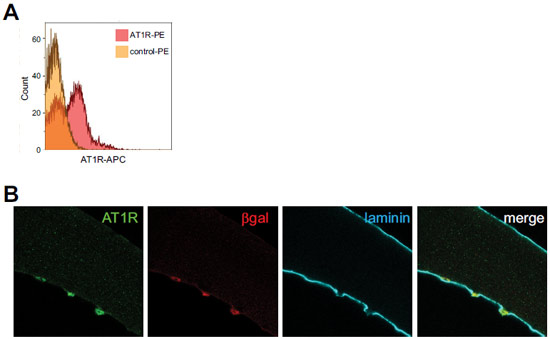Overview
- Peptide NSSTEDGIKRIQDDC, corresponding to amino acid residues 4-18 of human AT1 receptor (Accession P30556). Extracellular, N-terminus.
- Rat and mouse samples (1:200 – 1:500).
 Western blot analysis of mouse kidney (lanes 1 and 3) and mouse heart (lanes 2 and 4) membranes:1,2. Anti-Angiotensin II Receptor Type-1 (extracellular) Antibody (#AAR-011), (1:500).
Western blot analysis of mouse kidney (lanes 1 and 3) and mouse heart (lanes 2 and 4) membranes:1,2. Anti-Angiotensin II Receptor Type-1 (extracellular) Antibody (#AAR-011), (1:500).
3,4. Anti-Angiotensin II Receptor Type-1 (extracellular) Antibody, preincubated with Angiotensin II Receptor Type-1 (extracellular) Blocking Peptide (#BLP-AR011). Western blot analysis of rat liver (lanes 1 and 3) and rat kidney (lanes 2 and 4) membranes:1,2. Anti-Angiotensin II Receptor Type-1 (extracellular) Antibody (#AAR-011), (1:200).
Western blot analysis of rat liver (lanes 1 and 3) and rat kidney (lanes 2 and 4) membranes:1,2. Anti-Angiotensin II Receptor Type-1 (extracellular) Antibody (#AAR-011), (1:200).
3,4. Anti-Angiotensin II Receptor Type-1 (extracellular) Antibody, preincubated with Angiotensin II Receptor Type-1 (extracellular) Blocking Peptide (#BLP-AR011).
- Rat brain sections.
- 5-10 μg antibody/1x106 cells.
- The blocking peptide is not suitable for this application.
- Live intact rat C6 glioma cells (1:100).
Angiotensin II receptor type 1 (AT1 receptor, AGTR1) is one of the receptors that binds the octapeptide hormone Angiotensin II (Ang II).
Ang II is the peptide hormone that generates most of the known effects of the renin-angiotensin system (RAS). Ang II is generated from the angiotensinogen protein by the actions of renin, angiotensin converting enzyme (ACE) and other peptidases. Ang II has a central role in cardiovascular homeostasis by regulating vasoconstriction, renal Na+ and water readsorption. In addition, Ang II induces cell growth and proliferation and has pro-inflammatory effects.
Most of the physiological actions of Ang II are mediated by AT1 receptor a member of the 7-transmembrane domain, G protein-coupled receptor (GPCR) superfamily.
The AT1 receptor is coupled to a Gq/11 protein that activates phospholipase C (PLC) and leads to production of inositol 1,4,5-trisphosphate (IP3) and intracellular Ca2+ mobilization. In addition to the rapid actions mediated by IP3 and Ca2+ signaling, AT1 receptor elicits other signaling responses including activation of the MAPK and Jak/STAT. Together, these signaling pathways mediate most of Ang II cellular responses that include, control of hormone secretion, regulation of cell growth and apoptosis, regulation of ion channels activation and cell migration.
In accordance with the pleiotropic actions of Ang II, the AT1 receptor has a wide distribution with high levels detected in the adrenal gland, kidney, brain, heart, liver, etc.
As is the case with many other peptide receptors, the AT1 receptor undergoes ligand-induced endocytosis, a process that contributes to receptor desensitization and sequestration and contributes to regulate receptor signaling.
Application key:
Species reactivity key:

Expression of AT1R in mouse satellite cells and mouse myofibers.A. Indirect flow cytometry of mouse satellite cells using Anti-Angiotensin II Receptor Type-1 (extracellular) Antibody (#AAR-011). B. Immunocytochemical staining of intact cultured mouse myofibers using same antibody as in A.Adapted from Yoshida, T. et al. (2013) J. Biol. Chem. 288, 23823. with permission of the American Society for Biochemistry and Molecular Biology.
